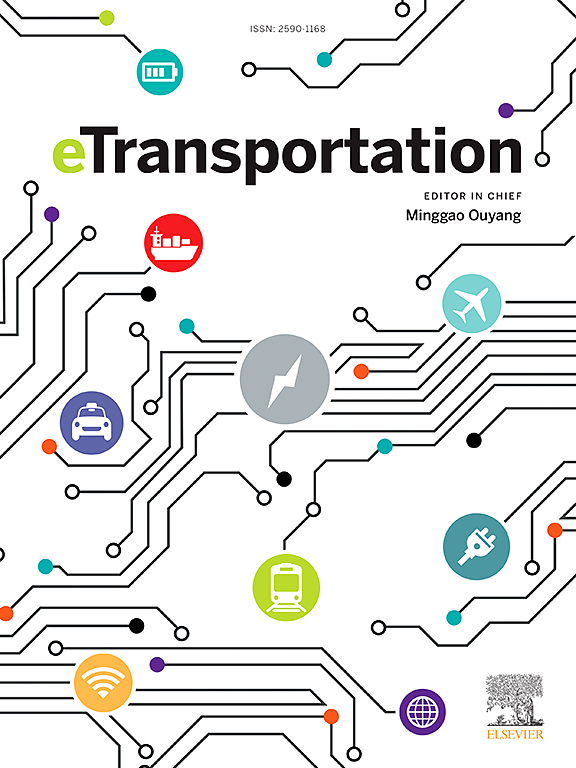Enhancing safety of electric aircraft Batteries: Degradation and thermal runaway behavior at extreme altitudes
IF 17
1区 工程技术
Q1 ENERGY & FUELS
引用次数: 0
Abstract
The operating performance and thermal safety of lithium-ion batteries (LIBs) in high-altitude scenarios are prime concerns for their reliable applications in various fields. High-altitude environments, characterized by low ambient pressure and temperature, can accelerate LIB degradation and increase the risk of thermal runaway (TR). Unlike previous studies focusing solely on ambient pressure or ambient temperature, this work quantifies their high-altitude coupled effects on the battery performance as well as the TR characteristics. Herein, experiments and simulations are combined to analyze the hybrid pulse charge/discharge behavior, direct current internal resistance (DCIR), over-discharge and recharge/re-discharge performance, and TR characteristics of 26650 NiCoMn LIBs under various ambient pressure and temperature conditions. The results show that low ambient pressure at 20 kPa increases the DCIR of LIB by 7.16 mΩ, raises battery temperature by 4.3 °C, lowers energy efficiency to 92.2 %, and advances TR occurrence with mass loss increasing to 7.5 g. Low ambient temperature at 50 °C causes abrupt changes in battery voltage (up to 6.8009 V during pulse charge and down to 2.0641 V during pulse discharge) and increases the DCIR to 284.8 mΩ. When low ambient pressure and low ambient temperature are combined, energy efficiency decreases to 93.5 % and the peak TR temperature of LIB reduces to 214.2 °C at 20 kPa & −50 °C. The research elucidates the relationship between performance/TR behaviors of LIB and individual/coupled environmental factors, shedding new insights into the operation and safety of LIB in the aviation sector. This facilitates to establishing tailored LIB designs and adaptive thermal management strategies to mitigate failure risks in high-altitude applications.
提高电动飞机电池的安全性:在极端高度的退化和热失控行为
锂离子电池在高海拔环境下的工作性能和热安全性是其在各个领域可靠应用的首要问题。低气压、低温度的高海拔环境会加速锂电池降解,增加热失控(TR)的风险。与以往的研究只关注环境压力或环境温度不同,这项工作量化了它们对电池性能和TR特性的高海拔耦合效应。本文将实验与仿真相结合,分析了26650 NiCoMn lib在不同环境压力和温度条件下的混合脉冲充放电行为、直流内阻(DCIR)、过放电和充放电/再放电性能以及TR特性。结果表明,在20 kPa的低环境压力下,锂离子电池的DCIR提高了7.16 mΩ,电池温度提高了4.3℃,能量效率降低到92.2%,并促进了TR的发生,质量损失增加到7.5 g。在50℃的低环境温度下,电池电压突变(脉冲充电时高达6.8009 V,脉冲放电时下降到2.0641 V), DCIR增加到284.8 mΩ。低环境压力和低环境温度相结合时,电能效率降至93.5%,在20 kPa &时,锂离子电池的峰值TR温度降至214.2℃;−50°C。本研究阐明了LIB性能/TR行为与个体/耦合环境因素之间的关系,为航空领域LIB的运行和安全提供了新的见解。这有助于建立量身定制的LIB设计和自适应热管理策略,以降低高海拔应用中的故障风险。
本文章由计算机程序翻译,如有差异,请以英文原文为准。
求助全文
约1分钟内获得全文
求助全文
来源期刊

Etransportation
Engineering-Automotive Engineering
CiteScore
19.80
自引率
12.60%
发文量
57
审稿时长
39 days
期刊介绍:
eTransportation is a scholarly journal that aims to advance knowledge in the field of electric transportation. It focuses on all modes of transportation that utilize electricity as their primary source of energy, including electric vehicles, trains, ships, and aircraft. The journal covers all stages of research, development, and testing of new technologies, systems, and devices related to electrical transportation.
The journal welcomes the use of simulation and analysis tools at the system, transport, or device level. Its primary emphasis is on the study of the electrical and electronic aspects of transportation systems. However, it also considers research on mechanical parts or subsystems of vehicles if there is a clear interaction with electrical or electronic equipment.
Please note that this journal excludes other aspects such as sociological, political, regulatory, or environmental factors from its scope.
 求助内容:
求助内容: 应助结果提醒方式:
应助结果提醒方式:


